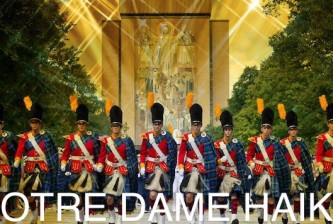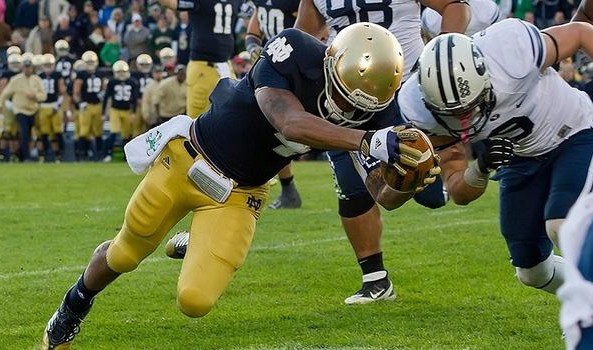Notre Dame's run offense may consist primarily of zone plays (outside zone was the top run check last season), but the Irish are not afraid to dial up power run plays from a variety of formations and personnel groupings. With Brian Kelly acknowledging that Notre Dame will likely run fewer option plays this season, the Irish may look to complement their zone running scheme with more power run plays like "Dart" or "Power O." Today we'll look at the Power O and how the Irish run it from a one-back set.
What is the Power O?
The Power O is a downhill running play traditionally run from a two-back set. The offensive line down blocks, i.e., blocks away from the playside, while the fullback kicks out the defensive end. Meanwhile, the backside guard pulls and blocks the first defender he finds inside the fullback's block. The running back takes the handoff and follows the guard through the hole. Below is a diagram of the Power O from the I formation.
(via Strong Football)
One of the beauties of the Power O is its adaptability. Over the last decade, teams have increasingly run the play from one-back formations. By replacing the fullback with an additional receiver, the offense forces the defense to remove a defender from the box to respect the threat of a bubble screen. The result is less congestion in the running lanes and better blocking angles. Notes from the 2013 coaches clinic illustrate how the Irish run the Power O from a one-back set.
(via Spread Football)
Let's look at the three keys to Notre Dame's one-back Power O.
1. Controlling the Sam linebacker
The quarterback is responsible for identifying the Sam (a.k.a. the strong side linebacker) and adjusting the play based on the Sam's alignment. If the Sam lines up over the slot receiver, the offense should have a blocker for every defender in the box; if he stays in the box, the quarterback has the option to throw a bubble screen to the slot receiver. Below is an example of the Irish offense controlling the Sam by throwing a bubble screen on a designed Power O.
Notre Dame lines up in the Pistol formation* with receivers T.J. Jones and Robby Toma to the field and Michael Floyd to the boundary. Tulsa is in a two-deep shell with the strong safety 14 yards off the line of scrimmage. The Golden Hurricane have seven men in the box, including the Sam (circled).
Rees recognizes the Sam rushing off the edge and throws a bubble screen to Toma. The play was clearly a designed run because Chris Stewart is pulling from his backside guard position and Cierre Wood has to duck to avoid hitting Rees as he throws.
Jones' assignment on this play is to execute a "push crack" block. A push crack typically involves the outside receiver taking three steps down field before breaking inside to block the safety. If the cornerback crosses his face, however, the receiver has the option of blocking the corner instead. Here, Jones blocks the corner as Toma cuts upfield and picks up a first down.
The bubble screen worked in the previous example because Tulsa's safeties were in a two-deep shell. However, if the defense does not play both safeties deep, the quarterback has the option of motioning the slot receiver into the backfield to get an additional blocker at the point of attack. The following play from the 2012 Blue-Gold game illustrates how motioning the receiver into the backfield allows the offense to control the Sam.
The offense lines up in a one-back set with tight end Ben Koyack lined up in the slot. The Sam is lined up just outside tight end Alex Welch, and the strong safety is creeping toward the line of scrimmage. Before the snap, Andrew Hendrix motions Koyack into the backfield so Koyack can kick-out the Sam and provide an extra blocker at the point of attack.
As you can see, Koyack seals the edge. His block allows Welch and Tate Nichols to combo block the defensive end, leaving linebacker Kendall Moore for the pulling guard.
2. Pulling Guard
In addition to illustrating how the offense uses motion to get an extra blocker at the point of attack, the previous play is also a good example of the backside guard pulling and knocking out the first defender he meets.
Bruce Heggie lines up at left guard. At the snap, he pulls and gets to the second level to block Kendall Moore. Heggie's block allows George Atkinson to cut upfield for a solid gain.
3. Downhill to the A gap
Although the Power O was traditionally more of an off-tackle play, most teams run the play to the A/B gaps because "the quickest way to gash the defense is straight down the field." As you can see from the clinic notes, it appears Notre Dame's coaches follow this downhill approach and instruct the running backs to hit the A gap before looking to cutback. The following play from the 2012 Stanford game highlights the downhill nature of the play.
Notre Dame lines up with George Atkinson at running back and three receivers. The Sam linebacker hovers between the box and the slot receiver. Although it looks like Stanford has eight men in the box, one of the defenders is the boundary corner who should have no impact on a run to the opposite side of the formation.
Atkinson takes a lateral step before hitting the gap just inside guard Mike Golic Jr.'s block on the middle linebacker. Atkinson makes a few nifty moves in traffic on his way to an eight-yard gain.
Conclusion
The Power O is a great downhill play. It's the kind of play the Irish will need to grind out a close game when everyone in the stadium knows a run is coming. The offensive line should have no problems creating holes for Notre Dame's running backs. The only question is which back is best suited for this type of downhill run.
*The 2010 Tulsa game is the last game I can recall that the Irish used the Pistol formation extensively. It will be interesting to see if Notre Dame runs more Pistol this season. Chris Ault, the inventor of the Pistol formation, spoke at the coaches clinic this past spring and the diagram from coach Alford's presentation shows the Power O being run from the Pistol formation.



































